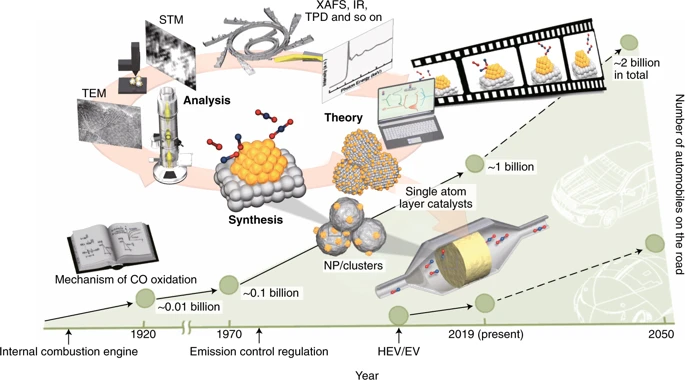将来の自動車用の高密度単原子触媒に向けて
Towards dense single-atom catalysts for future automotive applications
2019年7月11日 Nature Catalysis 2 : 7 doi: 10.1038/s41929-019-0282-y

CO酸化は、自動車用触媒反応における重要な主要反応であり、その基本性と、排ガス規制との技術的関連性のために、1970年代から広く研究されている。本Reviewでは、高活性な触媒を設計するために必要かつ重要な知見についてまとめるために、単原子または原子数個からなる最先端のCO酸化触媒について、反応経路を含めて詳細に調べた。触媒のサイズ、構造、形状、合金化度の制御による化学ポテンシャルの変調は、触媒と酸化物担体およびCO分子と触媒自体の相互作用を変化させる。本論文では、化学ポテンシャル変調による高性能触媒の実現に向けての最新の取り組みについて概観すると同時に、現代の自動車触媒研究と、持続可能な社会のために必要な将来の自動車用触媒研究との間に欠けている部分についても指摘、考察する。
Corresponding Author
東 相吾
株式会社豊田中央研究所
CO oxidation is an important primary reaction in automotive catalysis, and has been studied extensively since the 1970s because of its fundamental nature and technological relevance to emission control regulations. In this Review, we investigate the development of state-of-the-art catalysts for CO oxidation and consider the important achievements in the design of good catalysts via a detailed scrutiny of CO oxidation pathways for single-atom and few-atom cluster catalysis, which constitute a subset of the emerging technology of atomically dispersed and nanostructured oxide-supported catalysts. We see a recent effort towards achieving high-performance catalysts via chemical potential tuning, in which the size, structure, shape and degree of alloys are controlled to alter the electronic structure, catalyst-oxide support interactions and resulting interactions between adsorbates and the catalyst. We present a missing link in modern catalysis research in terms of the future development of automotive catalysts and related issues that must be satisfactorily resolved for sustainable and environment-friendly solutions.

